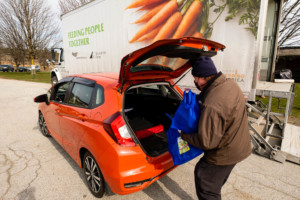We Can Solve Hunger: Commentary from Vermont Foodbank and Hunger Free Vermont on the USDA’s 2020 Food Insecurity Data
 The USDA’s September 8 report showing that food insecurity in the United States for the year 2020 remained level, as compared pre-pandemic 2019 numbers, shows that with adequate federal and state government support we can solve hunger in Vermont, and across the nation. Vermont Foodbank and Hunger Free Vermont work every day to maximize governmental food programs and fill in the gaps with a charitable food response. This report shows that the vast expansion of government aid and strong partnerships between government and non-government organizations completely erased the massive COVID-induced surge in food insecurity. While food insecurity rates were too high before COVID, and far too many people still struggle to afford food, these findings show that with ample funding and resources, we can move the needle on hunger in America.
The USDA’s September 8 report showing that food insecurity in the United States for the year 2020 remained level, as compared pre-pandemic 2019 numbers, shows that with adequate federal and state government support we can solve hunger in Vermont, and across the nation. Vermont Foodbank and Hunger Free Vermont work every day to maximize governmental food programs and fill in the gaps with a charitable food response. This report shows that the vast expansion of government aid and strong partnerships between government and non-government organizations completely erased the massive COVID-induced surge in food insecurity. While food insecurity rates were too high before COVID, and far too many people still struggle to afford food, these findings show that with ample funding and resources, we can move the needle on hunger in America.
“In Vermont, we know there was a dramatic increase in people accessing charitable food when the pandemic hit, and that surge remains today” said John Sayles, CEO of the Vermont Foodbank. “Increases in government aid and public support meant food access was able to grow dramatically to meet the critical need.”
Anore Horton, Executive Director at Hunger Free Vermont, stresses that the increased federal funds targeted to 3SquaresVT, Meals on Wheels, and meals for children also allowed these stable nutrition programs to respond quickly to the pandemic. “The emergency expansion and added flexibility of our national food security system worked, and needs to be continued.,” said Horton. “We are far from a full recovery, and hunger is always an emergency.”
Both the state and federal government stepped in to provide needed support, in addition to community philanthropy and volunteers, enabling organizations to effectively increase food distribution at a critical time. Additionally, other governmental supports worked to address financial insecurity and the economic impact of the COVID-19 pandemic on households.
Pre-pandemic levels of hunger in Vermont were unacceptable, with nearly one in four people in Vermont experiencing food insecurity. During the COVID-19 crisis, this number rose to one in three. These numbers, which are higher than those reported by the USDA, represent more closely the number of people continuing to access charitable food resources in Vermont. Recovery will be long for many, especially BIPOC and vulnerable populations who have historically and disproportionately experienced even higher rates of food insecurity.
Targeted and collaborative emergency response prevented a further deepening of hunger in Vermont. While a triumph, this demonstrates the continued need for investment from government and partnership between government and non-government organizations to address, and ideally, end hunger in Vermont.
Food resources can be found at www.vermontfoodhelp.com and or by texting VFBSNAP to 85511.
